Simeng Sun
SWAN-GPT: An Efficient and Scalable Approach for Long-Context Language Modeling
Apr 11, 2025Abstract:We present a decoder-only Transformer architecture that robustly generalizes to sequence lengths substantially longer than those seen during training. Our model, SWAN-GPT, interleaves layers without positional encodings (NoPE) and sliding-window attention layers equipped with rotary positional encodings (SWA-RoPE). Experiments demonstrate strong performance on sequence lengths significantly longer than the training length without the need for additional long-context training. This robust length extrapolation is achieved through our novel architecture, enhanced by a straightforward dynamic scaling of attention scores during inference. In addition, SWAN-GPT is more computationally efficient than standard GPT architectures, resulting in cheaper training and higher throughput. Further, we demonstrate that existing pre-trained decoder-only models can be efficiently converted to the SWAN architecture with minimal continued training, enabling longer contexts. Overall, our work presents an effective approach for scaling language models to longer contexts in a robust and efficient manner.
L0-Reasoning Bench: Evaluating Procedural Correctness in Language Models via Simple Program Execution
Mar 28, 2025Abstract:Complex reasoning tasks often rely on the ability to consistently and accurately apply simple rules across incremental steps, a foundational capability which we term "level-0" reasoning. To systematically evaluate this capability, we introduce L0-Bench, a language model benchmark for testing procedural correctness -- the ability to generate correct reasoning processes, complementing existing benchmarks that primarily focus on outcome correctness. Given synthetic Python functions with simple operations, L0-Bench grades models on their ability to generate step-by-step, error-free execution traces. The synthetic nature of L0-Bench enables systematic and scalable generation of test programs along various axes (e.g., number of trace steps). We evaluate a diverse array of recent closed-source and open-weight models on a baseline test set. All models exhibit degradation as the number of target trace steps increases, while larger models and reasoning-enhanced models better maintain correctness over multiple steps. Additionally, we use L0-Bench to explore test-time scaling along three dimensions: input context length, number of solutions for majority voting, and inference steps. Our results suggest substantial room to improve "level-0" reasoning and potential directions to build more reliable reasoning systems.
How much do contextualized representations encode long-range context?
Oct 16, 2024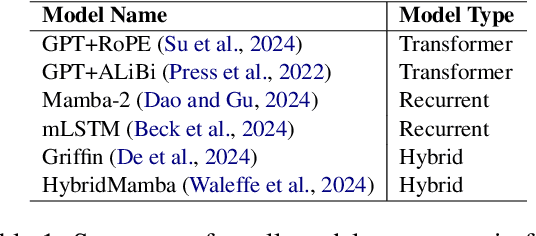
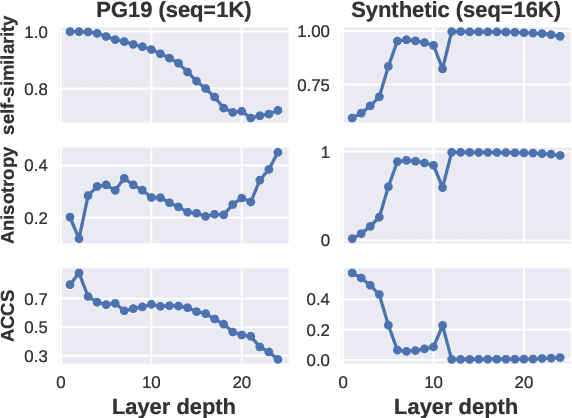
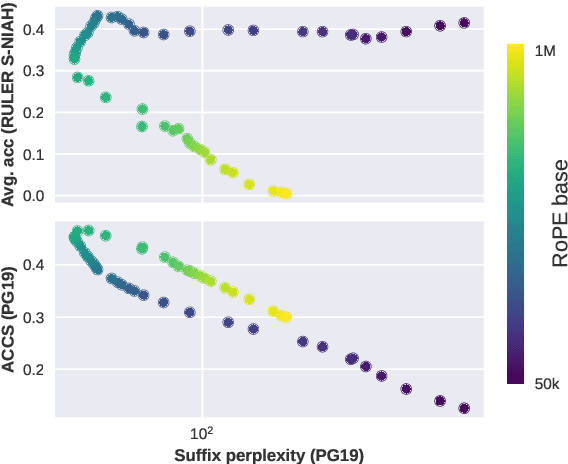
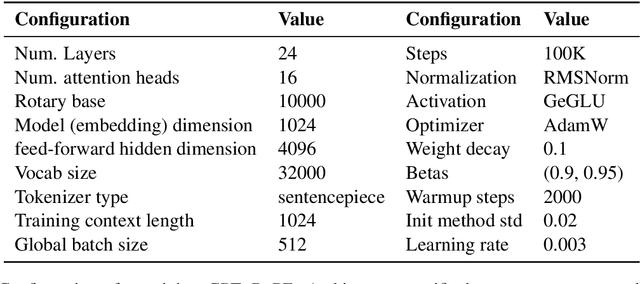
Abstract:We analyze contextual representations in neural autoregressive language models, emphasizing long-range contexts that span several thousand tokens. Our methodology employs a perturbation setup and the metric \emph{Anisotropy-Calibrated Cosine Similarity}, to capture the degree of contextualization of long-range patterns from the perspective of representation geometry. We begin the analysis with a case study on standard decoder-only Transformers, demonstrating that similar perplexity can exhibit markedly different downstream task performance, which can be explained by the difference in contextualization of long-range content. Next, we extend the analysis to other models, covering recent novel architectural designs and various training configurations. The representation-level results illustrate a reduced capacity for high-complexity (i.e., less compressible) sequences across architectures, and that fully recurrent models rely heavily on local context, whereas hybrid models more effectively encode the entire sequence structure. Finally, preliminary analysis of model size and training configurations on the encoding of long-range context suggest potential directions for improving existing language models.
nGPT: Normalized Transformer with Representation Learning on the Hypersphere
Oct 01, 2024



Abstract:We propose a novel neural network architecture, the normalized Transformer (nGPT) with representation learning on the hypersphere. In nGPT, all vectors forming the embeddings, MLP, attention matrices and hidden states are unit norm normalized. The input stream of tokens travels on the surface of a hypersphere, with each layer contributing a displacement towards the target output predictions. These displacements are defined by the MLP and attention blocks, whose vector components also reside on the same hypersphere. Experiments show that nGPT learns much faster, reducing the number of training steps required to achieve the same accuracy by a factor of 4 to 20, depending on the sequence length.
Suri: Multi-constraint Instruction Following for Long-form Text Generation
Jun 27, 2024



Abstract:Existing research on instruction following largely focuses on tasks with simple instructions and short responses. In this work, we explore multi-constraint instruction following for generating long-form text. We create Suri, a dataset with 20K human-written long-form texts paired with LLM-generated backtranslated instructions that contain multiple complex constraints. Because of prohibitive challenges associated with collecting human preference judgments on long-form texts, preference-tuning algorithms such as DPO are infeasible in our setting; thus, we propose Instructional ORPO (I-ORPO), an alignment method based on the ORPO algorithm. Instead of receiving negative feedback from dispreferred responses, I-ORPO obtains negative feedback from synthetically corrupted instructions generated by an LLM. Using Suri, we perform supervised and I-ORPO fine-tuning on Mistral-7b-Instruct-v0.2. The resulting models, Suri-SFT and Suri-I-ORPO, generate significantly longer texts (~5K tokens) than base models without significant quality deterioration. Our human evaluation shows that while both SFT and I-ORPO models satisfy most constraints, Suri-I-ORPO generations are generally preferred for their coherent and informative incorporation of the constraints. We release our code at https://github.com/chtmp223/suri.
RULER: What's the Real Context Size of Your Long-Context Language Models?
Apr 11, 2024Abstract:The needle-in-a-haystack (NIAH) test, which examines the ability to retrieve a piece of information (the "needle") from long distractor texts (the "haystack"), has been widely adopted to evaluate long-context language models (LMs). However, this simple retrieval-based test is indicative of only a superficial form of long-context understanding. To provide a more comprehensive evaluation of long-context LMs, we create a new synthetic benchmark RULER with flexible configurations for customized sequence length and task complexity. RULER expands upon the vanilla NIAH test to encompass variations with diverse types and quantities of needles. Moreover, RULER introduces new task categories multi-hop tracing and aggregation to test behaviors beyond searching from context. We evaluate ten long-context LMs with 13 representative tasks in RULER. Despite achieving nearly perfect accuracy in the vanilla NIAH test, all models exhibit large performance drops as the context length increases. While these models all claim context sizes of 32K tokens or greater, only four models (GPT-4, Command-R, Yi-34B, and Mixtral) can maintain satisfactory performance at the length of 32K. Our analysis of Yi-34B, which supports context length of 200K, reveals large room for improvement as we increase input length and task complexity. We open source RULER to spur comprehensive evaluation of long-context LMs.
TopicGPT: A Prompt-based Topic Modeling Framework
Nov 02, 2023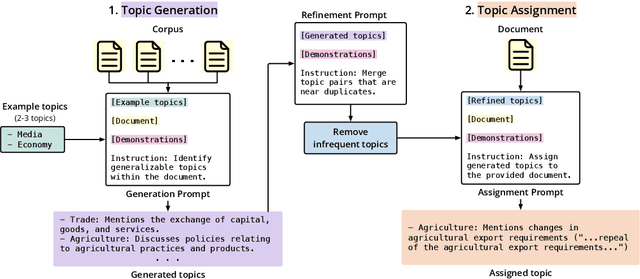
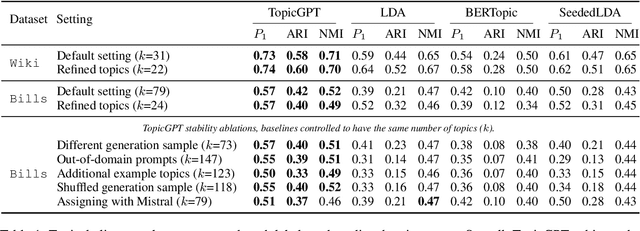

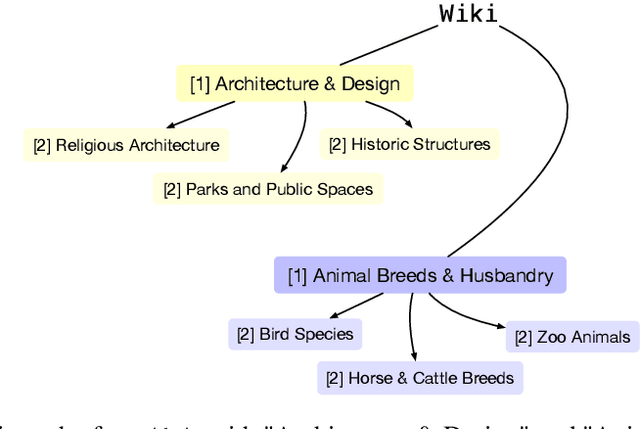
Abstract:Topic modeling is a well-established technique for exploring text corpora. Conventional topic models (e.g., LDA) represent topics as bags of words that often require "reading the tea leaves" to interpret; additionally, they offer users minimal semantic control over topics. To tackle these issues, we introduce TopicGPT, a prompt-based framework that uses large language models (LLMs) to uncover latent topics within a provided text collection. TopicGPT produces topics that align better with human categorizations compared to competing methods: for example, it achieves a harmonic mean purity of 0.74 against human-annotated Wikipedia topics compared to 0.64 for the strongest baseline. Its topics are also more interpretable, dispensing with ambiguous bags of words in favor of topics with natural language labels and associated free-form descriptions. Moreover, the framework is highly adaptable, allowing users to specify constraints and modify topics without the need for model retraining. TopicGPT can be further extended to hierarchical topical modeling, enabling users to explore topics at various levels of granularity. By streamlining access to high-quality and interpretable topics, TopicGPT represents a compelling, human-centered approach to topic modeling.
Exploring the impact of low-rank adaptation on the performance, efficiency, and regularization of RLHF
Sep 16, 2023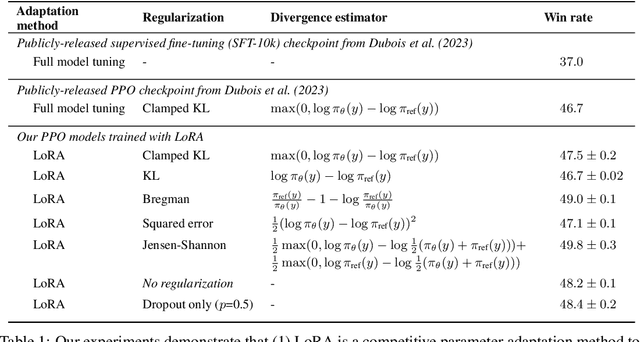
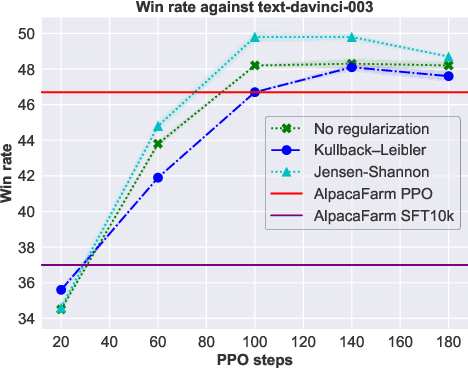
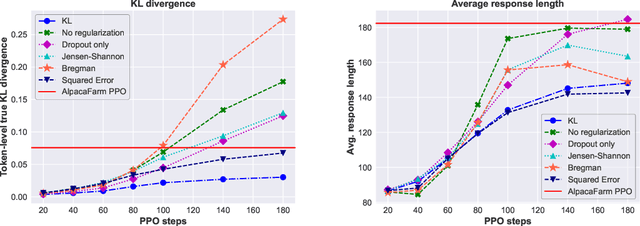

Abstract:During the last stage of RLHF, a large language model is aligned to human intents via PPO training, a process that generally requires large-scale computational resources. In this technical report, we empirically investigate an efficient implementation of RLHF using low-rank adaptation (LoRA), which allows us to align the LLaMA 7B checkpoint on the Alpaca dataset using only two A100 GPUs instead of the eight required for full model fine-tuning. Despite tuning only 0.2% of LLaMA 7B's parameters, our implementation achieves better performance than the publicly-released AlpacaFarm checkpoint with full model fine-tuning. Next, we analyze several configurations of our LoRA-based PPO implementation, varying the form of the KL regularization term in the training objective. We find that (1) removing this penalty term does not harm performance on the AlpacaFarm evaluation set under our LoRA setup; (2) other regularizers, such as Jensen-Shannon divergence, lead to improved performance; and (3) while PPO training negatively impacts the factuality of model-generated responses, training with LoRA largely mitigates this effect. We release our code and pretrained checkpoints to facilitate future research on more efficient RLHF.
PEARL: Prompting Large Language Models to Plan and Execute Actions Over Long Documents
May 23, 2023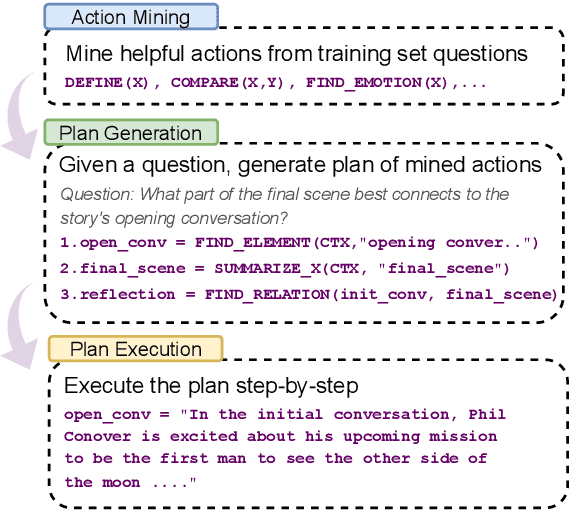

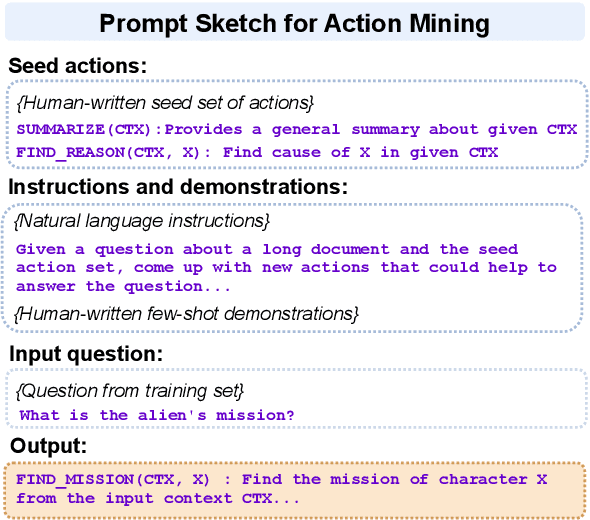
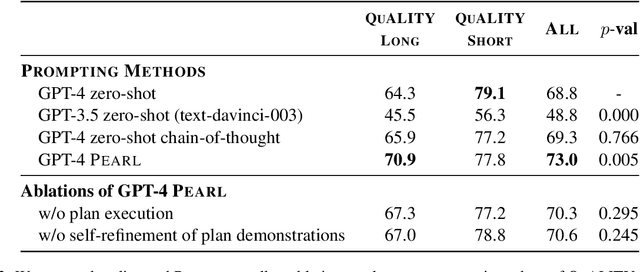
Abstract:Strategies such as chain-of-thought prompting improve the performance of large language models (LLMs) on complex reasoning tasks by decomposing input examples into intermediate steps. However, it remains unclear how to apply such methods to reason over long input documents, in which both the decomposition and the output of each intermediate step are non-trivial to obtain. In this work, we propose PEARL, a prompting framework to improve reasoning over long documents, which consists of three stages: action mining, plan formulation, and plan execution. More specifically, given a question about a long document, PEARL decomposes the question into a sequence of actions (e.g., SUMMARIZE, FIND_EVENT, FIND_RELATION) and then executes them over the document to obtain the answer. Each stage of PEARL is implemented via zero-shot or few-shot prompting of LLMs (in our work, GPT-4) with minimal human input. We evaluate PEARL on a challenging subset of the QuALITY dataset, which contains questions that require complex reasoning over long narrative texts. PEARL outperforms zero-shot and chain-of-thought prompting on this dataset, and ablation experiments show that each stage of PEARL is critical to its performance. Overall, PEARL is a first step towards leveraging LLMs to reason over long documents.
How Does In-Context Learning Help Prompt Tuning?
Feb 22, 2023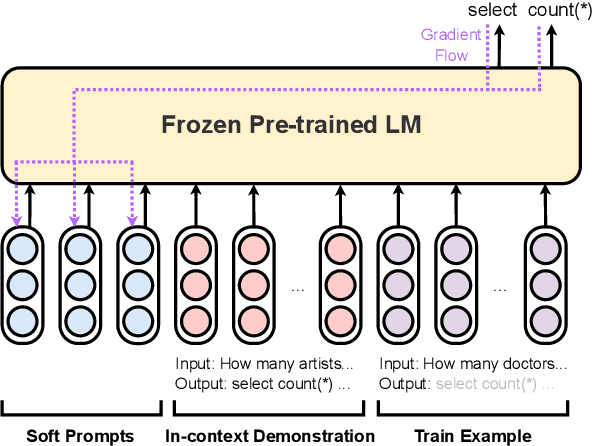
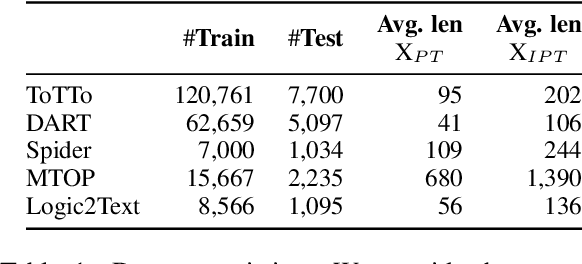
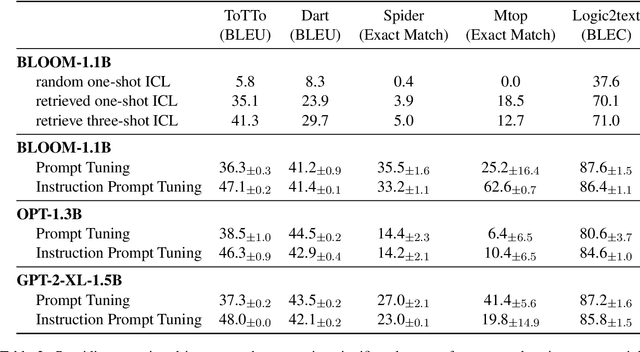

Abstract:Fine-tuning large language models is becoming ever more impractical due to their rapidly-growing scale. This motivates the use of parameter-efficient adaptation methods such as prompt tuning (PT), which adds a small number of tunable embeddings to an otherwise frozen model, and in-context learning (ICL), in which demonstrations of the task are provided to the model in natural language without any additional training. Recently, Singhal et al. (2022) propose ``instruction prompt tuning'' (IPT), which combines PT with ICL by concatenating a natural language demonstration with learned prompt embeddings. While all of these methods have proven effective on different tasks, how they interact with each other remains unexplored. In this paper, we empirically study when and how in-context examples improve prompt tuning by measuring the effectiveness of ICL, PT, and IPT on five text generation tasks with multiple base language models. We observe that (1) IPT does \emph{not} always outperform PT, and in fact requires the in-context demonstration to be semantically similar to the test input to yield improvements; (2) PT is unstable and exhibits high variance, but combining PT and ICL (into IPT) consistently reduces variance across all five tasks; and (3) prompts learned for a specific source task via PT exhibit positive transfer when paired with in-context examples of a different target task. Our results offer actionable insights on choosing a suitable parameter-efficient adaptation method for a given task.
 Add to Chrome
Add to Chrome Add to Firefox
Add to Firefox Add to Edge
Add to Edge